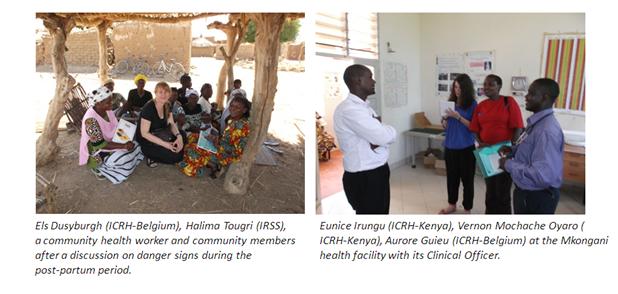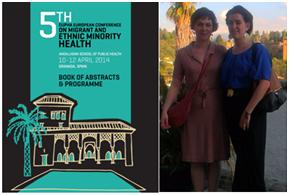 ICRH Global Newsletter ICRH Global Newsletter 28th of May, 2014 |
| PROJECTS |
HIV prevention interventions targeting sex workers and their clients in Kenya ICRH is a partner in a newly started 3-years study testing the feasibility of implementing venue-based HIV prevention interventions, targeting sex workers (SWs) and their clients, in Coast Province, Kenya. The study will develop and pilot a multi-level intervention in nightclubs/bars in Mombasa. In phase 1, we will assess the socio-cultural context of risk behavior, beliefs/understandings of HIV and risk; barriers to and facilitators of risk-reduction; and responses to intervention messages through in-depth interviews among SWs and clients. In phase 2, we will design a multi-level risk-reduction intervention tailored to the local context, that includes peer-delivered individual and group education, distribution of male and female condoms and lubricants, “street theater” presentations, on-site “moonlight” HIV testing and counseling and STI care, and manager meetings in Mombasa bars and nightclubs. In phase 3, we will test the intervention package for feasibility, acceptability, as well as participant level of exposure and intervention contamination at control sites via process measures, and test the feasibility of an intervention evaluation design to be used in a future study. The study is financed by a R01 grant of the National Institute for Health (NIH) of the United States and lead by the HIV Center for Clinical and Behavioral Studies at the New York State Psychiatric Institute and Columbia University. ICRH-Kenya will coordinate and implement the study on site, and ICRH-Belgium, together with Stat-Gent CRESCENDO of the University Ghent, will take the lead in the design and coordination of phase 3.
More information: yves.lafort@ugent.be |
Field visits in Burkina Faso and Kenya for the MOMI project In the course of April 2014, Els Duysburgh and Aurore Guieu visited the sites of Kwale (Kenya) and Kaya (Burkina Faso) together with the ICRH-Kenya and IRSS local teams.
The objective was to discuss the implementation of interventions as well as the monitoring and evaluation processes, and identify potential issues together. The time was devoted to visiting the health facilities and communities where MOMI activities in post-partum care and family planning are implemented. 
|
ICRH-Mozambique’s night clinics in Tete province ICRH has been implementing sexual and reproductive health activities in Tete city, Mozambique targeting female sex workers and long distance truck drivers (LDTD) since 2002.
Services have largely been provided using peer outreach and out of a container. In 2010, ICRH entered into public-private partnership with USAID and Vale Mining Company to construct a stand-alone Night Clinic replacing the containers in Moatize as part of VALE’s contribution to the National AIDS Response. The Night Clinic was officially opened in February 2013.
Efforts to construct a second clinic stalled until some 4 months ago when ICRH-M and VALE Foundation resuscitated the process. With new strategic partners including Tete Municipality, DPS, and ICRH-Mozambique, a site for the second clinic was identified at the Zambian Turn-off in Matema. The new site is a high transmission area and serves as unofficial truck stop and is frequented by sex workers. In addition to trucks, the place has several bars, taverns, and restaurants.
Several meetings among the partners were held to plan for the construction of the second clinic. An engineer was retained by ICRH-Mozambique to design the clinic with ICRH-M providing requirements based on lessons learned from first clinic and best practices in sex work programming from India and South Africa. Prototype of the state of the art clinic was presented to VALE Foundation and other stakeholders and was approved without modifications. However, when VALE Foundation sent their technical team to check out the proposed site for the clinic, they found the site unsuitable because of overhead power lines and other physical limitations. The project is on hold until a new site is found. We are confident that a new site will be found quickly because the Tete Municipality Mayor has stepped in to expedite the process.
More information: John Mkandawire, icrh.ssr.tete@tvcabo.co.mz
 Opening ceremony night clinic, February 2013.
Front: Left to right: Elsa Maria Fortes Xavier da Barca, Administrator of Moatize; Rachide Gogo, Tete Province Governor; Dra Carla Mosse, Provincial Directorate of Health; Colarinho Navaia, Mayor of Moatize. Back: VALE Mining Company staff

Night clinic Moatize |
| EVENTS |
MoU with Women’s Global Network for reproductive Rights
 ICRH has signed a Memorandum of Understanding with the Women’s Global Network of Reproductive Rights (WGNRR). ICRH has signed a Memorandum of Understanding with the Women’s Global Network of Reproductive Rights (WGNRR).
The WGNRR is a Southern-based global, member-driven network that builds and strengthens movements for Sexual and Reproductive Health, Rights and justice. They work to realise the full SRHR of all people, with a particular focus on the most marginalised. The Network was established in 1984 in the Netherlands, and has 30 years' experience of mobilising and campaigning on SRHR issues. In 2008, WGNRR relocated the Coordinating Office from Amsterdam to Manila, where it is currently headquartered. WGNRR has a consultative status with the United Nations (ECOSOC). In their Memorandum of Understanding, ICRH and the WGNRR commit to among others exchange in formation and actively explore cooperation opportunities.
|
5th EUPHA European Conference on Migrant and Ethnic Minority Health Between April 9-12th, Ines Keygnaert and Aurore Guieu travelled to Granada, Spain, to attend the 5th EUPHA European Conference on Migrant and Ethnic Minority Health hosted by the Andalusian School of Public Health.
The overall objective of the event was to reflect on the impact of the current systemic crisis in Europe on migrant and ethnic minority health and healthcare.
 ICRH-Belgium was represented with two oral presentations. Ines Keygnaert presented results from a study on the occurrence of sexual violence against sub-Saharan migrants in and around Morocco and its implications for the European Neighborhood Policy and chaired a session of oral presentations on policies and the economic crisis. Aurore Guieu shared conclusions from a literature review exploring sexual and reproductive health in the European Union legal and policy frameworks. ICRH-Belgium was represented with two oral presentations. Ines Keygnaert presented results from a study on the occurrence of sexual violence against sub-Saharan migrants in and around Morocco and its implications for the European Neighborhood Policy and chaired a session of oral presentations on policies and the economic crisis. Aurore Guieu shared conclusions from a literature review exploring sexual and reproductive health in the European Union legal and policy frameworks.
At the end of the conference, the Granada Declaration was issued, underlining the need for the public health community to speak out on behalf of the most vulnerable populations in Europe – and notably migrants – at a time when austerity measures become the rule across European states. The Granada Declaration may be endorsed by both individuals and organizations here.
The book of abstracts for the conference is available here. For more information: ines.keygnaert@ugent.be and aurore.guieu@ugent.be |
FGM Reference centre established at Ghent University Hospital The centre, which was launched 8 May 2014, will provide medical and psychological guidance and treatment to girls of 14 years and older who are victim to FGM.
 In order to optimize care for this vulnerable group of women, the Belgian National Institute for Health and Disability (RIZIV-INAMI) recognized two FGM reference centres: the Sint-Pieters Hospital in Brussels and the University Hospital in Ghent. The Women’s Clinic of the University Hospital has, together with ICRH, set up a specialized multidisciplinary consultation. The team is composed of gynaecologists, surgeons, nurses, midwifes, psychologists, sexologists and researchers. In order to optimize care for this vulnerable group of women, the Belgian National Institute for Health and Disability (RIZIV-INAMI) recognized two FGM reference centres: the Sint-Pieters Hospital in Brussels and the University Hospital in Ghent. The Women’s Clinic of the University Hospital has, together with ICRH, set up a specialized multidisciplinary consultation. The team is composed of gynaecologists, surgeons, nurses, midwifes, psychologists, sexologists and researchers.
Medial and paramedical staff is trained in identification and treatment of cultural practices that harm the well-being of women. The specialized consultations take place (only by appointment) every Wednesday morning in the Women’s Clinic of the University Hospital in Ghent. Appointments can be made at +32 9 332 37 82. More information: els.leye@ugent.be. |
May 28: International Day of Action for Women’s Health, Women’s Rights Defenders  In commemoration of 30 years of struggle and activism, women’s rights defenders and activists worldwide are re-launching May 28, the International Day of Action for Women’s Health. In commemoration of 30 years of struggle and activism, women’s rights defenders and activists worldwide are re-launching May 28, the International Day of Action for Women’s Health.
On May 28 1987, during the IV International Women’s Health Meeting in Costa Rica, women’s rights activists proposed to celebrate May 28 as the International Day of Action for Women’s Health. Nearly 30 years on, activists warn that the full realization of all women’s SRHR remains far from being addressed, as ‘women’s health’ has often been reduced to a limited understanding of maternal health, overlooking the actual needs of all women in their diversities. As a result, significant challenges persist, in terms of recognizing sexual rights in addition to reproductive rights, ensuring universal access to contraceptives and safe and legal abortion, as well as comprehensive sexuality education for young people, among other critical SRHR issues.
The Women’s Global Network for Reproductive Rights (WGNRR) is undertaking the re-launch of the May 28 campaign in collaboration with over 20 international, regional and national organizations, in an effort to mobilize women all over the world to demand the inclusion of their human right to health in the Post-2015 Development Agenda, of which our sexual and reproductive health and rights are an integral part. Interested individuals and organizations are encouraged to visit www.may28.org to learn more about the campaign, the May 28 Call for Action, what they can do in their communities and ways in which they can participate.
|
| ICRH - PEOPLE |
Marlise Richter
 Marlise was awarded her PhD in July 2013 and has relocated to Cape Town, South Africa. Marlise was awarded her PhD in July 2013 and has relocated to Cape Town, South Africa.
She is working as a consulting researcher with the University of the Western Cape on a project on HIV and migration in the context of the Western Cape, while also conducting research for the Southern African Litigation Centre on female chiefs in Lesotho. Her advocacy work focuses on sex worker and migrant rights with an emphasis on the decriminalisation of sex work in South Africa.
More information: marlise.richter@gmail.com |
Rita Verhelst
 Dr. Rita Verhelst is leaving ICRH after having worked for many years at Ghent University as a biotechnologist with specialization in medical molecular microbiology and virology. Dr. Rita Verhelst is leaving ICRH after having worked for many years at Ghent University as a biotechnologist with specialization in medical molecular microbiology and virology.
Rita started working for Ghent University in 1994 at the AIDS reference laboratory. In 2000, after a 3-years stay at Innogenetics, she returned to Ghent University to pursue a PhD in medical molecular microbiology. As a post-doctoral researcher at ICRH the focus of Rita’s research was on the characterization of the cervicovaginal microbiome and STI diagnostics. Rita leaves ICRH to pursue new career opportunities.
More information: riet7@icloud.com
|
Beatrice Crahay
 Dr. Beatrice Crahay is leaving ICRH Mozambique as Country Director. Dr. Beatrice Crahay is leaving ICRH Mozambique as Country Director. Beatrice joined ICRH Mozambique as its first Country Director in 2011. Under her leadership, the organization has grown substantially over the past 3 years, both in number of projects and staff, while at the same time she had the challenging task of developing all organizational and management tools needed in running the association. She was also instrumental in developing ICRH-M’s first Strategic Plan. Besides leading and representing the organization, Beatrice was directly in charge of the implementation of the project “A demonstration project for the implementation of the WHO antenatal care model in Mozambique: A cluster randomized controlled trial”.
More information: beatrice.crahay@gmail.com |
Sally Griffin
 Sally Griffin will be joining ICRH Mozambique as Country Director in June, replacing Beatrice Crahay. Sally Griffin will be joining ICRH Mozambique as Country Director in June, replacing Beatrice Crahay. Sally has a Masters in Reproductive and Sexual Health Research from the London School of Hygiene & Tropical Medicine, with a dissertation on “Determinants of condom use by sex workers in Nepal with clients and other sexual partners: A quantitative study”. She has over 15 years of experience working in the area of sexual and reproductive health and rights, mainly in Mozambique and Angola. This has included experience working in both senior management and technical positions.
More information: icrh.coord@tdm.co.mz |
Gilda Gondola
 Gilda Gondola is leaving ICRH-Mozambique as Senior Research Officer. Gilda Gondola is leaving ICRH-Mozambique as Senior Research Officer. Gilda joined ICRH Mozambique in 2011. With her social sciences background, and as holder of a Master in Public Health, she was mainly responsible for the coordination and implementation of the projects in the area of Maternal and Child Health, more specifically the EU funded project “MOMI - Missed Opportunities in Maternal and Child Health” and other projects with DANIDA, UNICEF funding in Tete province, and more recently also giving support to a Family Planning project in Maputo province. Gilda leaves ICRH to pursue new career opportunities.
More information: gildagondola@gmail.com |
| PUBLICATIONS |
Guidelines on contraception and human rights
WHO has published guidance on Ensuring human rights in the provision of contraceptive information and services.
These guidelines provide recommendations for programmes as to how they can ensure that human rights are respected, protected and fulfilled, while services are scaled up to reduce unmet need for contraception. Both health data and international human rights laws and treaties were incorporated into the guidance, which is complementary to existing WHO recommendations for sexual and reproductive health programmes, including guidance on family planning, maternal and newborn health, safe abortion, and core competencies for primary health care.
The objective of this document is to provide guidance for policy-makers, managers, providers and other stakeholders in the health sector on some of the priority actions needed to ensure that different human rights dimensions are systematically and clearly integrated into the provision of contraceptive information and services.
The guidelines are available online at: http://www.who.int/reproductivehealth/publications/family_planning/human-rights-contraception/en/. |
History of Abuse and Operative Delivery
The main aim of this study was to assess whether a history of abuse, reported during pregnancy, was associated with an operative delivery.
The Bidens study, a cohort study in six European countries (Belgium, Iceland, Denmark, Estonia, Norway, and Sweden) recruited 6724 pregnant women attending routine antenatal care. History of abuse was assessed through questionnaire and linked to obstetric information from hospital records. Among 3308 primiparous women, sexual abuse as an adult increased the risk of an elective Cesarean Section (CS), and the likelihood for a non-obstetrically indicated CS. Women expressing current suffering from the reported adult sexual abuse had the highest risk for an elective CS. Neither physical abuse (in adulthood or childhood ,18 years), nor sexual abuse in childhood increased the risk of any operative delivery among primiparous women. Among 3416 multiparous women, neither sexual, nor emotional abuse was significantly associated with any kind of operative delivery, while physical abuse had an increased AOR for emergency CS of 1.51.
The authors conclude that sexual abuse as an adult increases the risk of an elective CS among women with no prior birth experience, in particular for non-obstetrical reasons. Among multiparous women, a history of physical abuse increases the risk of an emergency CS.
Berit Schei, Mirjam Lukasse, Elsa Lena Ryding, Jacquelyn Campbell, Helle Karro, Hildur Kristjansdottir, Made Laanpere, Anne-Mette Schroll, Ann Tabor, Marleen Temmerman, An-Sofie Van Parys, Anne-Marie Wangel, Thora Steingrimsdottir. A History of Abuse and Operative Delivery – Results from a European Multi-Country Cohort Study. PLOS ONE, January 2014 , Volume 9, Issue 1, e87579. |
Newborn care
A comprehensive needs assessment for newborn care in Indonesia, Lao People’s Democratic Republic and the Philippines.
Between 1990 and 2011, global neonatal mortality decline was slower than that of under-five mortality. As a result, the proportion of under-five deaths due to neonatal mortality increased. This increase is primarily a consequence of decreasing post-neonatal and child under-five mortality as a result of the typical focus of child survival programmes of the past two decades on diseases affecting children over four weeks of age. Newborns are lagging behind in improved child health outcomes. The aim of this study was to conduct a comprehensive, equity-focussed newborn care assessment and to explore options to improve newborn survival in Indonesia, Lao People’s Democratic Republic (PDR) and the Philippines. Newborn health policies, services and care in the three countries were assessed through document review, interviews and health facility visits. Findings were triangulated to describe newborns’ health status, the health policy and the health system context for newborn care and the equity situation regarding newborn survival.
Main findings: (1) In the three countries, decline of neonatalmortality is lagging behind compared to that of under-five mortality. (2) Comprehensive newborn policies in line with international standards exist, although implementation remains poor. An important factor hampering implementation is decentralisation of the health sector, which created confusion regarding roles and responsibilities. Management capacity and skills at decentralised level were often found to be limited. (3) Quality of newborn care provided at primary healthcare and referral level is generally substandard. Limited knowledge and skills among providers of newborn care are contributing to poor quality of care. (4) Socio-economic and geographic inequities in newborn care are considerable.The authors conclude that there is an urgent need to address weak leadership and governance regarding newborn care, quality of newborn care provided and inequities in newborn care. Child survival programmes focussed on children over four weeks of age have shown to have positive outcomes. Similar efforts as those used in these programmes should be considered in newborn care.
Els Duysburgh, Birgit Kerstens, Melissa Diaz, Vini Fardhdiani, Katherine Ann V Reyes,
Khamphong Phommachanh, Marleen Temmerman, Basil Rodriques and Nabila Zaka. Newborn care in Indonesia, Lao People’s Democratic Republic and the Philippines: a comprehensive needs assessment. BMC Pediatrics 2014, 14:46. http://www.biomedcentral.com/1471-2431/14/46 |
Lactobacillus-dominated cervicovaginal microbiota, HIV/STI prevalence and genital HIV viral load in African women.
Cervicovaginal microbiota not dominated by lactobacilli may facilitate transmission of HIV and other sexually transmitted infections (STIs), miscarriages, preterm births and sepsis in pregnant women.
However, little is known about the exact nature of the microbiological changes that cause these adverse outcomes. In this study, cervical samples of 174 Rwandan female sex workers were analyzed cross-sectionally using a phylogenetic microarray. Furthermore, HIV-1 RNA concentrations were measured in cervicovaginal lavages of 58 HIV-positive women among them. We identified six microbiome clusters, representing a gradient from low semi-quantitative abundance and diversity dominated by Lactobacillus crispatus (cluster R-I, with R denoting 'Rwanda') and L. iners (R-II) to intermediate (R-V) and high abundance and diversity (R-III, R-IV and R-VI) dominated by a mixture of anaerobes, including Gardnerella, Atopobium and Prevotella species. Women in cluster R-I were less likely to have HIV (P=0.03), herpes simplex virus type 2 (HSV-2; P<0.01), and high-risk human papillomavirus (HPV; P<0.01) and had no bacterial STIs (P=0.15). Statistically significant trends in prevalence of viral STIs were found from low prevalence in cluster R-I, to higher prevalence in clusters R-II and R-V, and highest prevalence in clusters R-III/R-IV/R-VI. Furthermore, only 10% of HIV-positive women in clusters R-I/R-II, compared with 40% in cluster R-V, and 42% in clusters R-III/R-IV/R-VI had detectable cervicovaginal HIV-1 RNA (Ptrend=0.03). The authors conclude that L. crispatus-dominated, and to a lesser extent L. iners-dominated, cervicovaginal microbiota are associated with a lower prevalence of HIV/STIs and a lower likelihood of genital HIV-1 RNA shedding.
Borgdorff H, Tsivtsivadze E, Verhelst R, Marzorati M, Jurriaans S, Ndayisaba GF, Schuren FH, van de Wijgert JH. Lactobacillus-dominated cervicovaginal microbiota associated with reduced HIV/STI prevalence and genital HIV viral load in African women. The ISME Journal advance online publication, 6 March 2014; doi:10.1038/ismej.2014.26. |
The incidence and severity of community assault in Khayelitsha, South Africa
Anecdotal evidence suggests that victims of community assault (CA) are worse off than other assault cases, but scientific data on the rate and severity of CA cases are lacking for SA.
Therefore a case count study was conducted to estimate the rate of CA among adults in Khayelitsha and comparing the injury severity and survival probability between cases of CA and other assault (non-CA) cases. A consecutive case series was conducted in four healthcare centres in Khayelitsha during July - December 2012 to capture all CA cases during this period. A retrospective folder review was performed on all cases of CA and on a control group of non-CA cases to compare injury severity and estimate survival probability. A total of 148 adult cases of CA occurred over the study period. Based on an estimate population of 275,300 adults in Khayelitsha of ≥18 years, the rate of adult cases of CA that received healthcare in Khayelitsha was 1.1/1,000 person-years. For non-CA, the estimated rate was 19/1,000 person-years. The Injury Severity Scores in the CA group were significantly higher than in the non-CA group (p<0.001), with a median Injury Severity Score of 3 in CA cases versus 1 in non-CA cases. Comparison between the CA and non-CA groups showed that a Glasgow Coma Scale <15 (20.1% versus 5.4%, respectively), referral to the tertiary hospital (33.8% versus 22.6%, respectively), and crush syndrome (25.7% versus 0.0%, respectively) were all more common in CA cases. Survival probabilities were similar in both groups.
This study confirms that the rate of CA among adults in Khayelitsha is high, and the severity of injuries sustained by CA victims is substantially higher than in other assault cases. The findings beg for multi-sectoral action to curb the medical and social consequences of assault in SA. Furthermore, social science research is needed to improve our understanding of the psychology and sociology behind CAs and to develop evidence-led prevention strategies, the feasibility and effectiveness of which also require further investigation.
Sheron Forgus, Wim Delva, Christine Hauptfleisch, Srini Govender, Julia Blitz. The incidence and severity of community assault in Khayelitsha, South Africa. S Afr Med J 2014;104(4):299-301. DOI:10.7196/SAMJ.7615 |
Pregnancy outcomes in Libya before and during the armed conflict
Stressful life events experienced by pregnant women may lead to adverse obstetric outcomes.
This study in Benghazi, Libya compared the rates of preterm, low-birth-weight and caesarean-section births at Al-Jamhouria hospital in the months before and during the armed conflict in Libya in 2011. Data were collected on all women admitted to the delivery ward during February to May 2011 (the months of the most active fighting in the city) (n= 7096), and October to December 2010 (the months immediately before the war) (n = 5935). Compared with the preceding months there was a significant rise during the conflict in the rate of deliveries involving preterm (3.6% versus 2.5%) and low-birth-weight (10.1% versus 8.5%) infants and caesarean sections (26.9% versus 25.3%). Psychosocial stress may have been a factor (among others) in an increase in negative pregnancy outcomes, and
obstetric hospitals should be aware of these issues in times of war.
Z. Bodalal, K. Agnaeber, N. Nagelkerke, B. Stirling, M. Temmerman and O. Degomme. Pregnancy outcomes in Benghazi, Libya, before and during the armed conflict in 2011. EMHJ, Vol. 20 No. 3, 2014 Eastern Mediterranean Health Journal, La Revue de Santé de la Méditerranée orientale. |
Spousal discordance on fertility preference
This study assesses the effect of spousal agreement levels regarding fertility preference and spousal communication on contraceptive practice among married couples in Jimma zone, Ethiopia.
Quantitative data were collected in a cross-sectional study from March to May 2010 in Jimma
zone, Ethiopia, using a multistage sampling design covering six districts. In each of the 811 couples included in the survey, both spouses were interviewed. Concordance between the husband and wife was assessed using different statistics and tests including concordance rates, ANOVA, Cohen’s ? and McNemar’s test for paired samples. Multivariate analysis was computed to ascertain factors associated with contraceptive use.
Over half of the couples wanted more children and 27.8% of the spouses differed about the desire for more children. In terms of sex preference, there was a 48.7% discord in couples who wanted to have more children. At large, spousal concordance on the importance of family planning was positive. However, it was the husband’s favourable attitude towards family planning that determined a couple’s use of contraception. Overall, contraceptive prevalence was 42.9%. Among the groups with the highest level of contraceptive users, were couples where the husband does not want any more children. Spousal communication about the decision to use contraception showed a positive association with a couple’s contraceptive prevalence.
The authors conclude that family planning programs aiming to increase contraceptive uptake could benefit from findings on spousal agreement regarding fertility desire, because the characteristics of each spouse influences the couple’s fertility level. Disparities between husband and wife about the desire for more children sustain the need for male consideration while analysing the unmet need for contraception. Moreover, men play a significant role in the decision making concerning contraceptive use. Accordingly, involving men in family planning programs could increase a couple’s contraceptive practice in the future.
Tizta Tilahun, Gily Coene, Marleen Temmerman and Olivier Degomme. Spousal discordance on fertility preference and its effect on contraceptive practice among married couples in Jimma zone, Ethiopia. Reproductive Health 2014, 11:27. http://www.reproductive-health-journal.com/content/11/1/27 |
‘Sexual health is dead in my body”
This paper explores how refugees, asylum seekers and undocumented migrants in Belgium and the Netherlands define sexual health, search for sexual health information and perceive sexual health determinants.
Although migrants constitute an important proportion of the European population, little is known
about migrant sexual health. Existing research mainly focuses on migrants’ sexual health risks and accessibility issues while recommendations on adequate sexual health promotion are rarely provided.
Applying Community-based Participatory Research as the overarching research approach, the au-thors conducted 223 in-depth interviews with refugees, asylum seekers and undocumented migrants in Belgium and the Netherlands.
The results indicate that gender and age do not appear to be decisive determinants. However, incorporated cultural norms and education attainment are important to consider in desirable sexual health promotion in refugees, asylum seekers and undocumented migrants in Belgium and the Netherlands. Furthermore, results demonstrate that these migrants have a predominant internal health locus of control. Yet, most of them feel that this personal attitude is hugely challenged by the Belgian and Dutch asylum system and migration laws which force them into a structural dependent situation inducing sexual ill-health. Conclusion: Refugees, asylum seekers and undocumented migrants in Belgium and the Netherlands are at risk of sexual ill-health. Incorporated cultural norms and attained education are important determinants to address in desirable sexual health promotion. Yet, as their legal status demonstrates to be the key determinant, the prime concern is to alter organizational and societal factors linked to the Belgian and Dutch asylum system. Refugees, asylum seekers and undocumented migrants in Belgium and the Netherlands should be granted the same opportunity as Belgian and Dutch citizens have, to become equally in control of their sexual health and sexuality.
Ines Keygnaert, Nicole Vettenburg, Kristien Roelens and Marleen Temmerman. Sexual health is dead in my body: participatory assessment of sexual health determinants by refugees, asylum seekers and undocumented migrants in Belgium and the Netherlands. BMC Public Health 2014, 14:416. http://www.biomedcentral.com/1471-2458/14/416 |
Maternal mortality
Two recent UN publications provide new data on incidence and causes of maternal mortality.
New United Nations data show a 45% reduction in maternal deaths since 1990. An estimated 289 000 women died in 2013 due to complications in pregnancy and childbirth, down from 523 000 in 1990. Although knowledge on the number of women dying and the reasons behind their deaths is improving, much remains unrecorded and unreported and the estimates underscore the importance of having accurate data. Another WHO study, published today in "The Lancet Global Health", adds new knowledge about why these women are dying. "Global causes of maternal death: a WHO systematic analysis", finds that more than 1 in 4 maternal deaths are caused by pre-existing medical conditions such as diabetes, HIV, malaria and obesity, whose health impacts can all be aggravated by pregnancy. Other causes included: severe bleeding (mostly during and after childbirth) 27%; pregnancy-induced high blood pressure 14%; infections 11%; obstructed labour and other direct causes 9%; abortion complications 8%; blood clots (embolism) 3%.
Trends in Maternal Mortality: 1990 to 2013. Estimates by WHO, UNICEF, UNFPA, The World Bank and the United Nations Population Division. May 2014, ISBN: 978 92 4 150722 6.
http://www.who.int/reproductivehealth/publications/monitoring/maternal-mortality-2013/en/
Lale Say, Doris Chou, Alison Gemmill, Özge Tunçalp, Ann-Beth Moller, Jane Daniels, A Metin Gülmezoglu, Marleen Temmerman, Leontine Alkema. Global causes of maternal death: a WHO systematic analysis. The Lancet Global Health, Early Online Publication, 6 May 2014
http://www.thelancet.com/journals/langlo/article/PIIS2214-109X(14)70227-X/abstract |
Efficiency of antenatal care and childbirth services in in rural Tanzania
A cross-sectional study aimed at assessing the costs of providing antenatal care (ANC) and child-birth services in selected rural primary health care facilities in Tanzania.
In addition, the study analyzed determining factors of service provision efficiency in order to inform health policy and planning. This retrospective quantitative cross-sectional study was conducted in 11 health centers and dispensaries in Lindi and Mtwara rural districts. Cost analysis was carried out using step down cost accounting technique. Unit costs reflected efficiency of service provision. Multivariate regression analysis on the drivers of observed relative efficiency in service provision between the study facilities was conducted. Reported personnel workload was also described.
The health facilities spent on average 7 USD per capita in 2009. As expected, fewer resources were spent for service provision at dispensaries than at health centers. Personnel costs contributed a high approximate 44% to total costs. ANC and childbirth consumed approximately 11% and 12% of total costs; and 8% and 10% of reported service provision time respectively. On average, unit costs were rather high, 16 USD per ANC visit and 79.4 USD per childbirth. The unit costs showed variation in relative efficiency in providing the services between the health facilities. The results showed that efficiency in ANC depended on the number of staff, structural quality of care, process quality of care and perceived quality of care. Population-staff ratio and structural quality of basic emergency obstetric care services highly influenced childbirth efficiency.
The authors conclude that differences in the efficiency of service provision present an opportunity for efficiency improvement. Taking into consideration client heterogeneity, quality improvements are possible and necessary. This will stimulate utilization of ANC and childbirth services in resource-constrained health facilities. Efficiency analyses through simple techniques such as measurement of unit costs should be made standard in health care provision, health managers can then use the per-formance results to gauge progress and reward efficiency through performance based incentives.
Saronga HP, Duysburgh E, Massawe S, Dalaba MA, Savadogo G, Tonchev P, Dong H, Sauerborn R, Loukanova S. Efficiency of antenatal care and childbirth services in selected primary health care facilities in rural Tanzania: a cross-sectional study. BMC health services research 2014, 14(1):96.
|
| |
 ICRH Global Newsletter
ICRH Global Newsletter 

 In order to optimize care for this vulnerable group of women, the Belgian National Institute for Health and Disability (RIZIV-INAMI) recognized two FGM reference centres: the Sint-Pieters Hospital in Brussels and the University Hospital in Ghent. The Women’s Clinic of the University Hospital has, together with ICRH, set up a specialized multidisciplinary consultation. The team is composed of gynaecologists, surgeons, nurses, midwifes, psychologists, sexologists and researchers.
In order to optimize care for this vulnerable group of women, the Belgian National Institute for Health and Disability (RIZIV-INAMI) recognized two FGM reference centres: the Sint-Pieters Hospital in Brussels and the University Hospital in Ghent. The Women’s Clinic of the University Hospital has, together with ICRH, set up a specialized multidisciplinary consultation. The team is composed of gynaecologists, surgeons, nurses, midwifes, psychologists, sexologists and researchers. Marlise was awarded her PhD in July 2013 and has relocated to Cape Town, South Africa.
Marlise was awarded her PhD in July 2013 and has relocated to Cape Town, South Africa. Sally Griffin will be joining ICRH Mozambique as Country Director in June, replacing Beatrice Crahay.
Sally Griffin will be joining ICRH Mozambique as Country Director in June, replacing Beatrice Crahay.